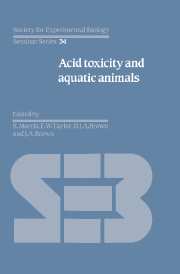Book contents
- Frontmatter
- Contents
- Contributors
- Units, Symbols and Formulae
- Preface
- Introduction: The causes and consequences of surface water acidification
- Invertebrate communities in acid streams
- Fish survival in acid waters
- Field studies on fisheries in acid waters in the UK
- Episodic changes in water quality and their effects on fish
- Acid–base regulation in fishes: 1. Mechanisms
- Acid–base regulation in fishes: 2. Biological responses and limitations
- Intracellular pH regulation and the effects of external acidification
- The physiological problems of fish in acid waters
- Laboratory studies on invertebrate survival and physiology in acid waters
- The physiological problems of crayfish in acid waters
- The effects of hydrogen and aluminium ions on fish gills
- The combined effects of pH and trace metals on fish ionoregulation
- Endocrine responses to acid stress in fish
- Commentary and conclusions
- Index
Invertebrate communities in acid streams
Published online by Cambridge University Press: 05 February 2012
- Frontmatter
- Contents
- Contributors
- Units, Symbols and Formulae
- Preface
- Introduction: The causes and consequences of surface water acidification
- Invertebrate communities in acid streams
- Fish survival in acid waters
- Field studies on fisheries in acid waters in the UK
- Episodic changes in water quality and their effects on fish
- Acid–base regulation in fishes: 1. Mechanisms
- Acid–base regulation in fishes: 2. Biological responses and limitations
- Intracellular pH regulation and the effects of external acidification
- The physiological problems of fish in acid waters
- Laboratory studies on invertebrate survival and physiology in acid waters
- The physiological problems of crayfish in acid waters
- The effects of hydrogen and aluminium ions on fish gills
- The combined effects of pH and trace metals on fish ionoregulation
- Endocrine responses to acid stress in fish
- Commentary and conclusions
- Index
Summary
Introduction
Stony streams normally contain a characteristic fauna of benthic macroinvertebrates, prominent among which are insects, especially Ephemeroptera, Plecoptera, Trichoptera and Diptera. Also present are flatworms, oligochaetes, a few malacostracan crustaceans and molluscs. In streams with moderate alkalinity and a pH of about 6 or more, the fauna is rich in total numbers of species (usually there are some 70–90 taxa) and many of these may be abundant. In acid streams where the mean pH is below 5.7–5.4, however, there is a distinct change in faunal composition. Some taxa disappear or become scarce, particularly mayflies, some caddisflies, crustaceans and molluscs. The fauna is thus impoverished in species and may contain only half the number of taxa found in less acid (soft water) streams.
For instance, in the upper River Tywi in west Wales a diverse fauna of 60–78 taxa occurs in streams containing mean concentrations of at least 85 μequiv l-1 calcium and magnesium, with mean pH 5.6 or above. At mean pH 5.3 or below, and slightly less calcium, only 46 taxa were found and these were generally sparse (Stoner, Gee & Wade, 1984). A similar reduction in numbers of taxa occurred at reduced pH in lowland streams of the Ashdown Forest in southern England (Townsend, Hildrew & Francis, 1983; Hildrew, Townsend & Francis, 1984).
- Type
- Chapter
- Information
- Acid Toxicity and Aquatic Animals , pp. 13 - 30Publisher: Cambridge University PressPrint publication year: 1989
- 53
- Cited by



